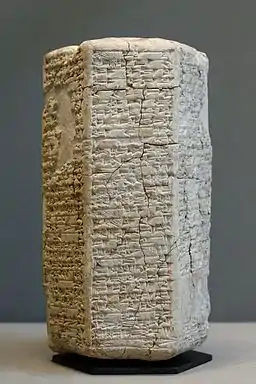Iddin-Dagan
Iddin-Dagan (Akkadian: 𒀭𒄿𒁷𒀭𒁕𒃶, Di-din-Dda-gan), fl. c. 1910 BC — c. 1890 BC by the short chronology or c. 1975 BC — c. 1954 BC by the middle chronology) was the 3rd king of the dynasty of Isin. Iddin-Dagan was preceded by his father Shu-Ilishu. Išme-Dagān[1] then succeeded Iddin-Dagan. Iddin-Dagan reigned for 21 years (according to the Sumerian King List.)[i 1] He is best known for his participation in the sacred marriage rite and the sexually-explicit hymn that described it.[2]
| Iddin-Dagan 𒀭𒄿𒁷𒀭𒁕𒃶 | |
|---|---|
| King of Isin | |
| Reign | fl. c. 1910 BC — c. 1890 BC |
| Predecessor | Shu-Ilishu |
| Successor | Ishme-Dagan |
| Akkadian | Iddin-Dagān |
| House | Dynasty of Isin |
| Father | Shu-Ilishu |
Biography

His titles included: “Mighty King” — “King of Isin” — “King of Ur” — “King of the Land of Sumer and Akkad.”[nb 1] The first year name recorded on a receipt for flour and dates[i 3] reads: “Year Iddin-Dagān (was) king and (his) daughter Matum-Niatum (“the land which belongs to us”) was taken in marriage by the king of Anshan.”[nb 2][3] Vallat suggests it was to Imazu (son of Kindattu, who was the groom and possibly the king of the region of Shimashki)[i 4] as he was described as the King of Anshan in a seal inscription, although elsewhere unattested. Kindattu had been driven away from the city-state of Ur by Išbi-Erra[i 5] (the founder of the First Dynasty of Isin), however; relations had apparently thawed sufficiently for Tan-Ruhurarter (the 8th king to wed the daughter of Bilalama, the énsí of Eshnunna.)[4]
There is only one contemporary monumental text of Iddin-Dagan that is extant. This is a fragment of a stone statue[i 6] with a votive inscription which invokes Ninisina and Damu to curse those who foster evil intent against it. Two later clay tablets[i 7] preserve an inscription recording an unspecified object fashioned for the god Nanna. These were found by the British archaeologist Sir Charles Leonard Woolley in a scribal school house in Ur. A tablet[i 8] from the Enunmaḫ in Ur dated to the 14th year of Gungunum (fl. c. 1868 BC — c. 1841 BC) of Larsa, after his conquest of the city, bears the seal impression of a servant of his. A tablet[i 9] described Iddin-Dagān’s fashioning of two copper festival statues for Ninlil, which were not delivered to Nippur until 170 years later by Enlil-bāni.[5] Belles-lettres preserve the correspondence from Iddin-Dagān to his general Sîn-illat about Kakkulātum and the state of his troops, and from his general describing an ambush by the Martu (Amorites).
The continued fecundity of the land was ensured by the annual performance of the sacred marriage ritual in which the king impersonated the god Dumuzi-Ama-ušumgal-ana and a priestess played the role of Inanna. A hymn describing Iddin-Dagan's performance of this ritual in ten sections (Kiruḡu) indicates that this ceremony involved a procession of: male prostitutes, wise women, drummers, priestesses, and priests bloodletting with swords to the accompaniment of music, followed by offerings and sacrifices for the goddess Inanna, or Ninegala.
The ceremony reached its climax with the copulation of the king and priestess[6] and is described thus:
She bathes (her) loins for the king. She bathes (her) loins for Iddin-Dagān. Holy Inanna bathes with soap, and sprinkles the floor with aromatic resin. The king then approached (her) loins with head raised high. Iddin-Dagān approached (her) loins with head raised high. Ama-ušumgal-ana lies down beside her and {caresses her holy thighs} (says:) "O my holy thighs! O my holy Inanna!." After the lady has made him rejoice with her holy thighs on the bed, after holy Inanna has made him rejoice with her holy thighs on the bed, she relaxes (?) with him on her bed: "Iddin-Dagān, you are indeed my beloved!"[7]
— šir-namursaḡa to Inanna for Iddin-Dagān, 9th Kiruḡu
There are four extant hymns addressed to Iddin-Dagan: this Sacred Marriage Hymn, a praise poem dedicated to the king, a war song, and a dedicatory prayer.
See also
Inscriptions
- Sumerian King List extant in 16 copies.
- Prism AO 8864, Louvre.
- Tablet UM 55-21-102, University Museum, Philadelphia.
- Dynastic list of the kings of Awan and Simashki, Sb 17729 in the Louvre.
- Išbi-Erra and Kindattu, tablets N 1740 + CBS 14051.
- MM 1974.26 Medelhavsmuseet, Stockholm.
- Tablets IM 85467 and IM 85466, National Museum of Iraq.
- Excavation number U 2682.
- Tablet UM L-29-578, University Museum Philadelphia.
Notes
- lugal-kala-ga, lugal-i-si-in-KI-ga (lugal-KI-úri-ma), lugal-KI-en-gi-KI-uri-ke4.
- mu dI-dan dDa-gan lugal-e [Ma]-tum-ni-a-tum [dumu-mí]-a-ni lugal An-ša-an(a)[ki] ba-an-tuk-a.
References
- Not to be confused with Išme-Dagān I or Išme-Dagān II of the Old Assyrian Empire
- D. O. Edzard (1999). Erich Ebeling; Bruno Meissner (eds.). Reallexikon der Assyriologie und Vorderasiatischen Archäologie: Ia - Kizzuwatna. Vol. 5. Walter De Gruyter Inc. pp. 30–31.
- David I Owen (October 1971). "Incomplete date formulae of Iddin-Dagān again". Journal of Cuneiform Studies. XXIV (1–2): 17. doi:10.2307/1359342. JSTOR 1359342. S2CID 163743791.
- Daniel T. Potts (1999). The archaeology of Elam: formation and transformation of an ancient Iranian State. Cambridge University Press. pp. 149, 162.
- Douglas Frayne (1990). Old Babylonian period (2003-1595 BC): Early Periods, Volume 4 (RIM The Royal Inscriptions of Mesopotamia). University of Toronto Press. pp. 77–90.
- Jeremy Black; Graham Cunningham; Eleanor Robson; Gabor Zolyomi, eds. (2006). The Literature of Ancient Sumer. Oxford University Press. pp. 262–267.
- Piotr Michalowski (2008). "The mortal kings of Ur: A short century of divine kingship in ancient Mesopotamia". In Nicole Brisch (ed.). Religion and Power: Divine Kingship in the Ancient World and Beyond. The University of Chicago. pp. 40–41.